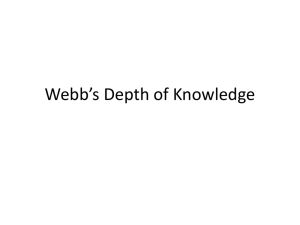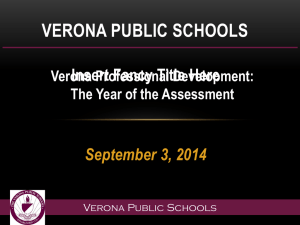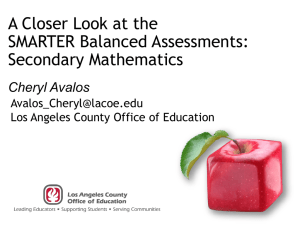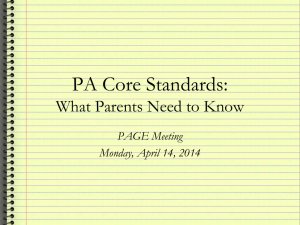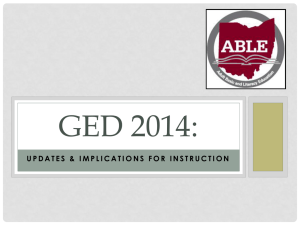Depth of Knowledge
advertisement
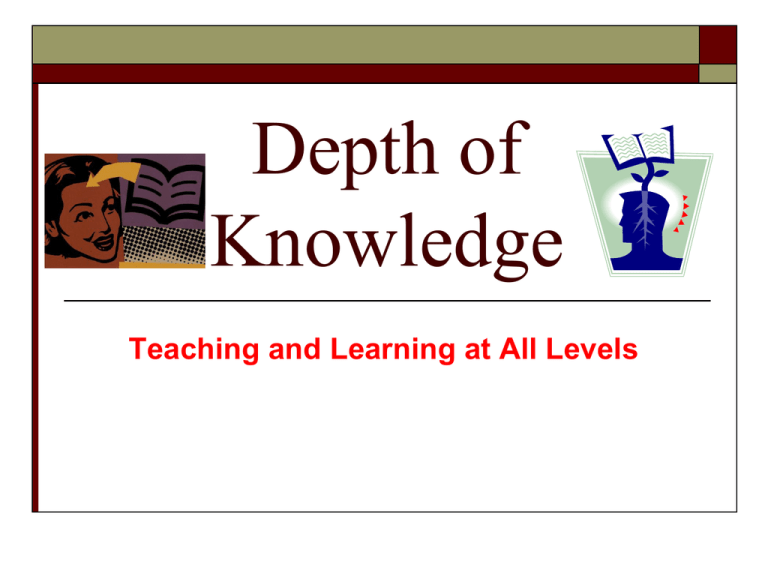
Depth of Knowledge Teaching and Learning at All Levels Depth of Knowledge Accessing Prior Knowledge Thoughtful Ed. Strategy K-W-L K-W-L K – What do I already KNOW about this topic? (Generate list of ideas) W – What do I WANT to know about this topic? (Generate Questions) L - What did I LEARN from this lesson? (Generate personal reflections) What do I KNOW? Generate a list of things you already know about DOK. (Individual) Share your list with a partner and add any additional information or ideas to your list. Now share as a group at your table. What do I WANT to know? Generate a list of questions you have about DOK. (Individual) Share your list with a partner and add any additional questions to your list. Now share as a group at your table. What did I LEARN? Experience a variety of learning opportunities about DOK Acquire new knowledge about DOK Find answers to some of your questions about DOK Reflect on what you have learned Depth of Knowledge Norman Webb Indicates the cognitive demand (thinking) for the state assessment. Defines the “ceiling” or highest DOK level for each Core Content standard for the state assessment. Guides item development for the state assessment. Depth of Knowledge Determined in the Core Content for Assessment. Every item that is assessed will have a DOK ceiling level. RD-10-1.0.2 Students will make predictions based on what is read. DOK 2 4 Levels of DOK Do NOT equate to performance levels of Novice, Apprentice, Proficient, and Distinguished Level 1: Recall and Reproduction Level 2: Skills and Concepts/Basic Reasoning Level 3: Strategic Thinking/Complex Reasoning Level 4: Extended Thinking/Reasoning Is the Ceiling the Limit? YES, for State Assessment NO, for Classroom Instruction If all students are to reach proficiency then the DOK ceiling for assessment is the minimum end goal for instruction for ALL students. Remember: DOK…. …is descriptive. …focuses on how deeply a student has to know the content in order to respond. …is NOT the same as difficulty. …is NOT the same as Bloom’s Taxonomy. Recall and Reproduction: Level 1 DOK 1 requires recall of information, such as a fact, definition, term, or performance of a simple process or procedure. Answering a Level 1 item can involve following a simple, wellknown procedure or formula. Simple skills and abilities or recall characterize DOK 1. 12 Recall and Reproduction: DOK 1 Examples List animals that survive by eating other animals Locate or recall facts explicitly found in text Describe physical features of places Determine the perimeter or area of rectangles given a drawing or labels Identify elements of music using musical terminology Identify basic rules for participating in simple games and activities 13 Skills/Concepts: Level 2 DOK 2 includes the engagement of some mental processing beyond recalling or reproducing a response. Items require students to make some decisions as to how to approach the question or problem. These actions imply more than one mental or cognitive process/step. 14 Skills/Concepts: DOK 2 Examples Compare desert and tropical environments Identify and summarize the major events, problem, solution, conflicts in literary text Explain the cause-effect of historical events Predict a logical outcome based on information in a reading selection Explain how good work habits are important at home, school, and on the job Classify plane and three dimensional figures Describe various styles of music 15 Strategic Thinking: Level 3 DOK 3 requires deep understanding as exhibited through planning, using evidence, and more demanding cognitive reasoning. The cognitive demands at Level 3 are complex and abstract. An assessment item that has more than one possible answer and requires students to justify the response they give would most likely be a Level 3. 16 Strategic Thinking DOK 3 Examples Compare consumer actions and analyze how these actions impact the environment Analyze or evaluate the effectiveness of literary elements (e.g., characterization, setting, point of view, conflict and resolution, plot structures) Solve a multiple-step problem and provide support with a mathematical explanation that justifies the answer 17 DOK Level 3 Examples Develop a scientific model for a complex idea Propose and evaluate solutions for an economic problem Explain, generalize or connect ideas, using supporting evidence from a text or source Create a dance that represents the characteristics of a culture 18 Extended Thinking: Level 4 DOK 4 requires high cognitive demand and is very complex. Students are expected to make connections—relate ideas within the content or among content areas—and have to select or devise one approach among many alternatives on how the situation can be solved. Due to the complexity of cognitive demand, DOK 4 often requires an extended period of time. 19 However, extended time alone is not the distinguishing factor. Task Thinking Collecting data samples over several months Recall Organizing the data in a chart Skills/ concepts Strategic Thinking Using this chart to make and justify predictions Developing a generalized model from this data and applying it to a new situation Extending Thinking 20 Extended Thinking: DOK 4 Examples Gather, analyze, organize, and interpret information from multiple (print and non print) sources to draft a reasoned report Analyzing author’s craft (e.g., style, bias, literary techniques, point of view) Create an exercise plan applying the “FITT (Frequency, Intensity, Time, Type) Principle” 21 Extended Thinking: DOK 4 Examples Analyze and explain multiple perspectives or issues within or across time periods, events, or cultures Specify a problem, identify solution paths, solve the problem, and report the results Write and produce an original play 22 The Depth of Knowledge is NOT determined by the verb, but by the context in which the verb is used and the depth of thinking required. 23 DOK 3- Describe a model that you might use to represent the relationships that exist within the rock cycle. (requires deep understanding of rock cycle and a determination of how best to represent it) DOK 2- Describe the difference between metamorphic and igneous rocks. (requires cognitive processing to determine the differences in the two rock types) DOK 1- Describe three characteristics of metamorphic rocks. (simple recall) Same verb—three DOK levels 24 Time for an activity! Name that DOK level. DOK Review Read each released assessment item as it appears on the screen. When your facilitator prompts you, hold up the card that corresponds to the DOK level of the question. SS-06-3.3.1 Big Idea: Markets are institutional arrangements. In a free market economy, the price and quality of goods and services are most strongly affected by A. B. C. D. advertising. competition. borrowing. regulation. Answer? DOK 2 Answer: DOK 2 This item requires students to understand how prices of goods and services are determined in present day market economies. Big Idea: Vocational Studies CCA 4.0: PL-04-4.1.02 Thomas has a part-time job working in a garden. This job would BEST help him prepare for a career in A. B. C. D. transportation. agriculture. fish and wildlife. dairy farming. Answer? DOK 2 Answer: DOK 2 Students must be able to differentiate between jobs in the career clusters. Big Idea: Vocational Studies CCA 4.0: PL-HS-4.1.05 The lifelong earning potential of an individual is generally related to his or her A. B. C. D. professional contracts. supervisor’s recommendation. volunteer experiences. educational training. Answer? DOK 2 Answer: DOK 2 Students will make a connection between education and lifelong earning potential. SC-HS-4.6.1 - (Big Idea: Energy Transformations) Answer? DOK 2 Answer: DOK 2 This question goes beyond simple recall. Students make the connection that a greater plant population (implied) will result in an increase in oxygen production. SS-08-1.2.1— (Big Idea: U.S. Constitution establishes a government of limited and shared powers). Under our system of checks and balances, the Supreme Court can limit the power of both the Congress and the President by A. B. C. D. impeaching public officials. vetoing a law. making appointments. declaring a law unconstitutional. Answer? DOK 1 Answer: DOK 1 This item requires students to recall information about how our system of checks and balances prevents the concentration of political power. Now What? Apply this knowledge…. Guiding Questions: What makes a question rigorous? How do rigorous questions support the transition to the Common Core Learning Standards (CCLS)? Introduction A key component of the transition to the Common Core Learning Standards (CCLS) is strengthening student work by examining and refining curriculum, assessment, and classroom instruction. Rigorous questions, tasks, and assessment are essential to driving the higher-order thinking and skills students need to be college- and career-ready The Depth of Knowledge Framework can help us examine the level of rigor in each of these areas to ensure that students are being pushed to meet the demands of the new standards. So what is rigor? Higher level thinking Ability to think about your thinkins and draw some conlussions Make connections, connect learning to what they already know Thinking critically Pplying their prior knoweldge to what they will learnn Pushing studetns to think beyond the tangible and proveable Challenging the mind to move from simplified language to a higher level that will produce meaningful experiences. So what is rigor: On your note-taking sheet record your definition of rigor. Keep it in mind throughout the rest of the activity! Depth of Knowledge Video Applying Depth of Knowledge Reading Math Science Writing Cognitive Rigor Matrices Revisions and Reflections Lets share any changes or revisions they would make to their original definitions of rigor. What’s one specific way he or she plans to apply or alter the way DOK in the classroom?



